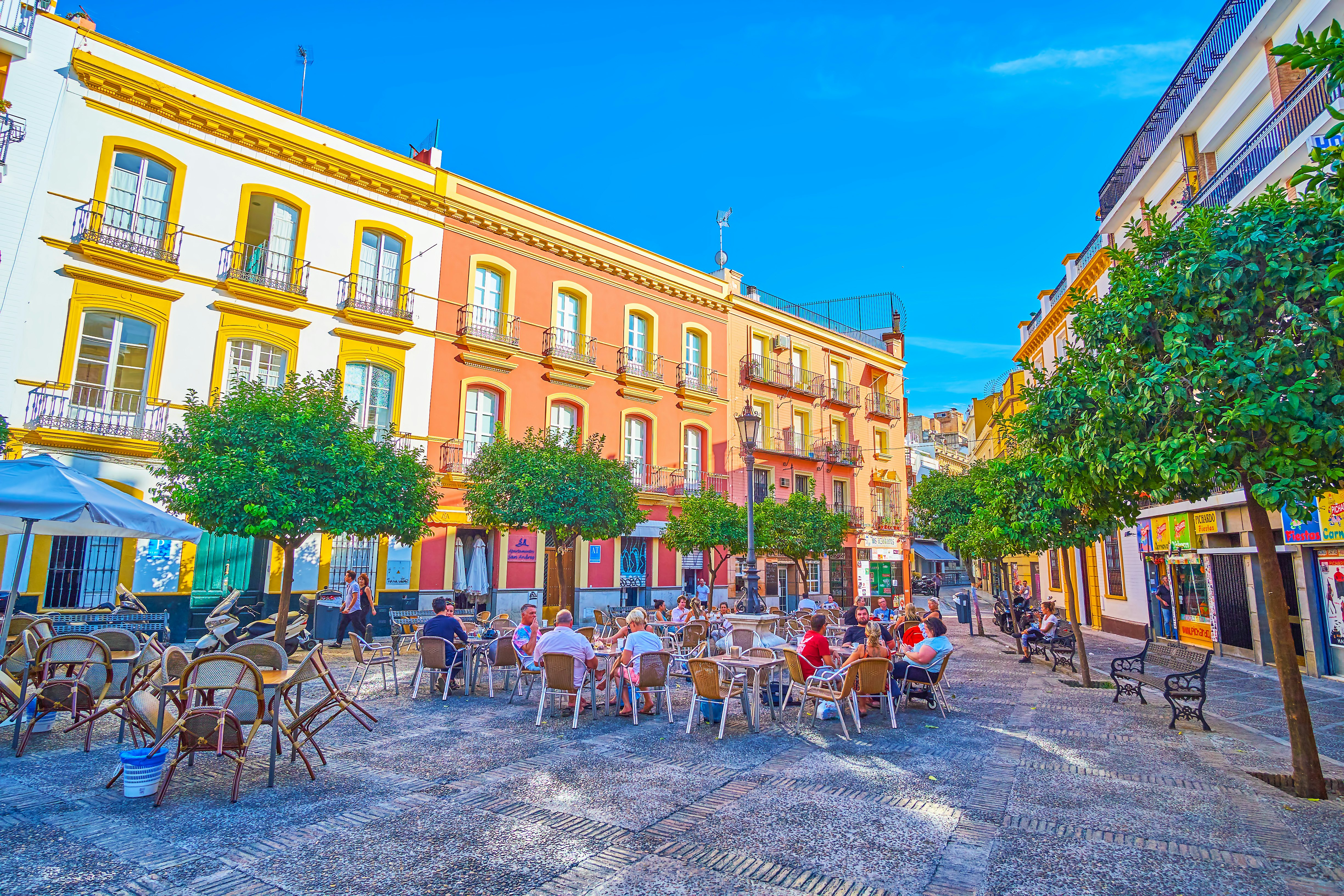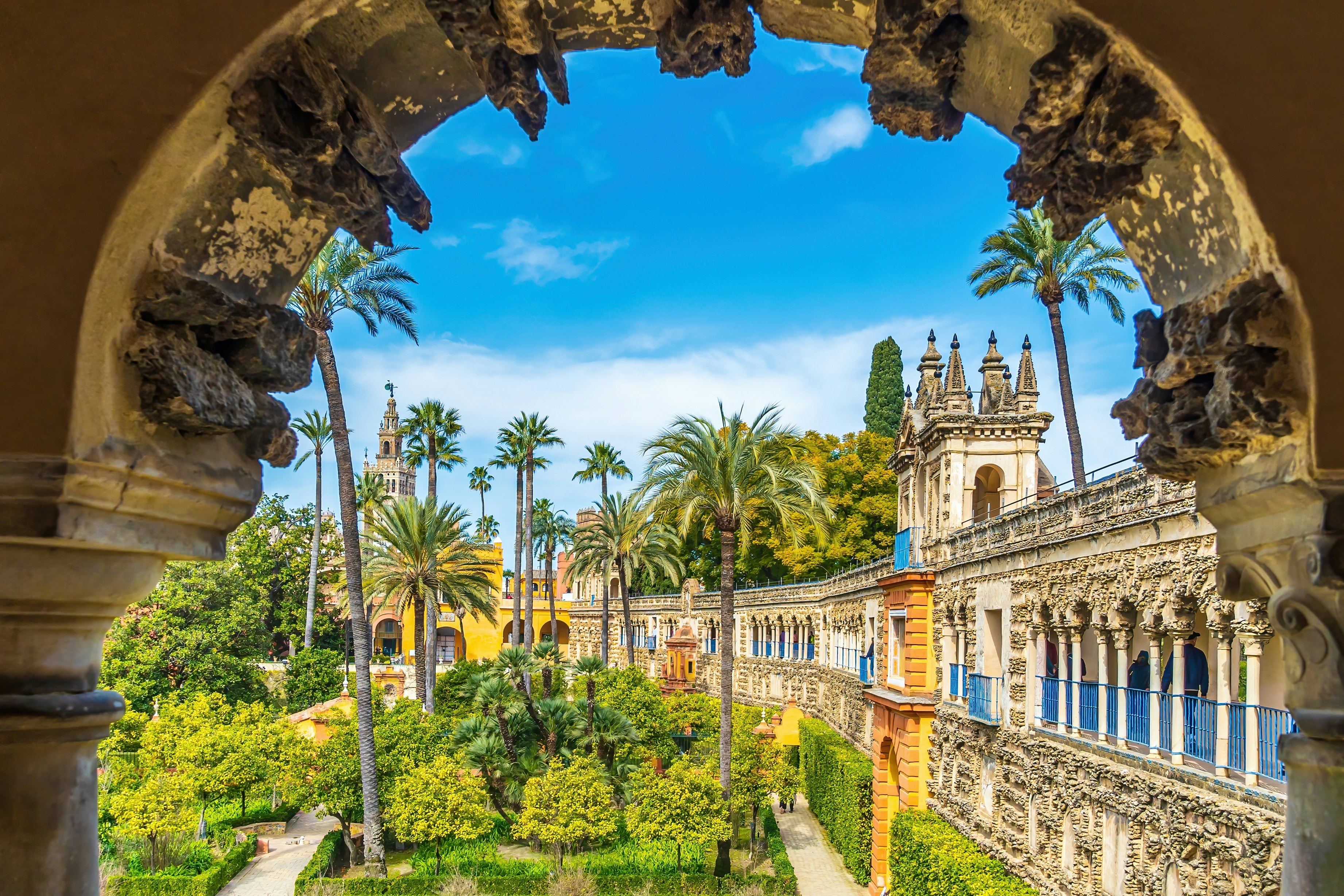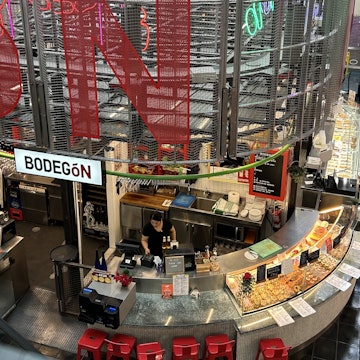

A flamenco dancer in Seville. Anastasia Krutikova/Shutterstock
From its imposing Gothic cathedral to its fading World Expo ’92 pavilions, Seville rewards the inquisitive visitor. And with a Mediterranean climate that remains largely dry and warm year-round, there’s never really a bad time to explore the sights in and around its historic core.
Seville’s inland location on the dry, sweltering plains of Andalucía means that it has some of the highest temperatures in Spain, climbing above 30°C (86°F) in summer but rarely dipping below 11°C (52°F) in winter. Whatever you plan to do, there are pros and cons to visiting at any time of year, so here are some tips to help you make the most of your visit to the lively Andalusian capital, no matter what the season.

May, June and September are best for urban exploring
Weather in Seville in late spring and early fall: This time of year should be warm but reasonable. You'll see highs of 33°C (91°F) and lows of 13°C (55°F). You shouldn't see much rainfall during these months.
The shoulder seasons in late spring and early fall are arguably the best times of year to visit Seville. Low rainfall coupled with hot weather sees the city thrumming with ambiance. But these advantages come with some caveats. Room prices are generally high, but a little flexibility around when you visit can still land you a good deal. Midweek is far better than the weekends, when there are more domestic visitors.
The streets are often at their busiest during the late spring as locals still haven’t left for their summer break, while throngs of visitors are descending to experience the city at its best. Although you can expect the afternoon heat to be uncomfortable at times, the dry weather and shady, narrow streets of Seville’s historic center make it easy to explore.
These conditions are ideal for exploring further afield, too. Loop in the old tile-making neighborhood of Triana, wander along the Río Guadalquivir past the Torre de Oro, and end up at the elegantly curving Plaza de España. Alternatively, hire an e-scooter and zip out to the moldering remains of the Expo ’92 Sevilla, with a giant globe and space rocket among the highlights.
In the evenings temperatures are ideal for wandering the city streets or sipping a tinto de verano cocktail at a streetside terrace bar. You might even overhear the strains of flamenco guitar drifting from an open window. Visit one of the many tablao flamenco theaters around town, such as the Casa de la Memoria and La Casa del Flamenco, and you can enjoy an impassioned show for yourself.

March to April is best for street-filling festivals
Weather in Seville in early spring: Seville sees average lows of 8°C (46°F) and highs of 22°C (72°F) during this time. You won't see too much rain, though April might bring you some frequent-but-brief showers.
As soon as midday temperatures creep past 20°C (70°F), sevillanos herald the end of winter the best way they know how – with lively festivals, which attract droves of visitors to the city. If you want to join the throngs of people lining the procession routes during both Semana Santa (Holy Week, running up to Easter) and the Feria de Abril, be sure to book your hotel months in advance (and expect peak season prices).
The festival season usually kicks off with Semana Santa. Although the festival is celebrated with fervor throughout Spain and the Catholic world, Seville hosts one of the most elaborate Holy Weeks. Between Palm Sunday and Easter Sunday, the streets are filled by processions of hooded penitents known as Nazarenos, belonging to one of Seville's bevy of religious fraternities. You’ll see them carrying flower-bedecked floats through the streets from scores of churches around the city to Seville's vast cathedral. Celebrations reach their peak of fervor in the early hours of Good Friday.
Hot on Holy Week’s coattails comes another week of festivities for the Feria de Abril, normally held a fortnight after the religious ceremonies end. Feria de Abril is a celebration of all things Andalusian; food (especially fried fish), culture (including horse parades during the daytime), dance (many locals don their finest flamenco attire) and light shows are highlights. At night, huge crowds of people descend on the thousand-or-so casetas (small booths, hosted by families and businesses) occupying the main festival site south of Triana for drinks, snacks and socializing.
Occasionally, inclement weather can blight these festivals. Rain can affect the Semana Santa parades as the holy effigies paraded around town are too valuable to risk getting wet, but nothing douses the Feria de Abril party spirit. Do pack a raincoat though, just in case.

February to March and October to November are best for comfortable crowd-evading
Weather in Seville during early spring and late fall: You could see lows around 9°C (47°F) and highs up to 20°C (68°F). Pack your umbrella, as things get quite wet in October and November.
It’s not uncommon for temperatures to be pleasant enough for comfortable alfresco dining in Seville in February, even if it’s snowing up in the Sierras. And while the restaurant terraces start to get busier, it’s a fantastic time to experience Seville’s atmosphere and energy at their purest. Nevertheless, as more people are catching on to Seville's charms, these months are becoming increasingly popular with visitors, broadening the shoulder season.
By the start of March, the air is perfumed with the sweet scent of azahar (orange blossom). It’s a great time to explore outdoor locations such as Parque María Luisa, where the sculpted gardens are fringed by captivating and family-friendly museums, such as the Museo de Artes y Costumbres Populares and the Museo Casa de la Ciencia.
Temperatures are also agreeable in late fall, another great window for exploring. During both of these periods, there’s a risk of rain, with an average of one in five days being wet. Pack a light jacket in case it rains, and to stay comfortable during the much cooler evenings.

July to August and December to January are best for budget travelers
Weather in Seville during high summer and winter: You'll see extremes during this time, with 38°C (100°F) regularly during July and August. The winter brings temps around 10-16°C (50-60°F). As for rainfall, you'll likely see a dry July and August but some showers in December and January.
During high summer, Seville is very hot, leading many to write the city off entirely at this time. But it’s a dry heat that can be worked around, and it might be worth risking, because while it’s high tourism season along the Spanish coastline, it’s low season in Seville. The city's hotels have very high standards and powerful air-conditioning, and many offer exceptional rates during the summer. A stay at a luxury property can often cost less than half the peak price.
So long as you’re happy to take a siesta or relax at a shaded cafe terrace in the afternoon to escape the hottest part of the day, you can spend the rest of your trip exploring usually overcrowded UNESCO World Heritage Sites such as the Catedral de Sevilla or the Real Alcázar’s palace and gardens in relative peace. This is also the perfect time to hop between the large, airy art galleries; make time for the Museo de Bellas Artes and the Centro Andaluz de Arte Contemporáneo, located in a building that served as a monastery and a porcelain factory before becoming the city’s main repository for modern art.
In winter, if you’re visiting Seville from places with cold winters such as the northern United States, Canada or more northerly parts of Europe, you’ll appreciate the mild, bright weather, with midlevel temperatures. Even at this time of year, there are fewer than seven rainy days a month, and families will enjoy the spectacle of the costumed Día de los Reyes Magos parades on January 5.
Winter hotel prices can vary. While mostly following the same low-season pricing trends seen in summer, both Christmas and New Year’s Eve are major holidays in Spain and prices often come close to shoulder or peak season rates at this time.
















